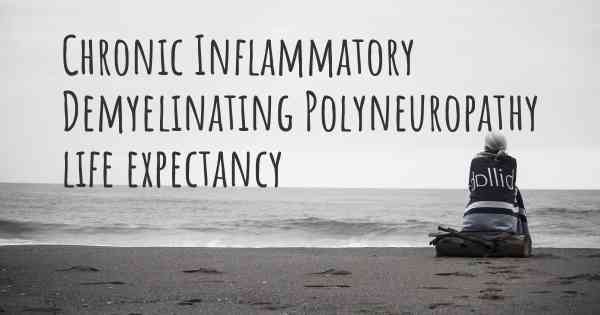What is the life expectancy of someone with Chronic Inflammatory Demyelinating Polyneuropathy?
Life expectancy of people with Chronic Inflammatory Demyelinating Polyneuropathy and recent progresses and researches in Chronic Inflammatory Demyelinating Polyneuropathy

Chronic Inflammatory Demyelinating Polyneuropathy (CIDP) is a rare neurological disorder characterized by progressive weakness and impaired sensory function. The life expectancy of individuals with CIDP can vary depending on various factors such as age, overall health, and response to treatment.
Early diagnosis and appropriate treatment can significantly improve the prognosis and quality of life for CIDP patients. With proper management and ongoing care, many individuals with CIDP can experience long-term remission or stabilization of their symptoms.
It is important for individuals with CIDP to work closely with their healthcare team to develop a personalized treatment plan and regularly monitor their condition. By doing so, they can optimize their chances of leading a fulfilling and extended life.
Chronic Inflammatory Demyelinating Polyneuropathy (CIDP) is a rare neurological disorder characterized by chronic inflammation of the peripheral nerves. It is considered a chronic condition that can significantly impact a person's quality of life. While CIDP is a chronic condition, it is important to note that it is not typically a life-threatening disease.
The life expectancy of someone with CIDP is generally not affected by the condition itself. However, it is crucial to manage the symptoms and complications associated with CIDP to ensure a good quality of life. With proper treatment and care, individuals with CIDP can lead fulfilling lives.
Treatment:
Treatment for CIDP aims to control symptoms, prevent further nerve damage, and improve overall functioning. The most common treatment approach involves the use of immunosuppressive drugs, such as corticosteroids, intravenous immunoglobulin (IVIG), and plasma exchange (also known as plasmapheresis). These treatments help reduce inflammation and suppress the immune response that damages the nerves.
Physical therapy and rehabilitation exercises are often recommended to improve muscle strength, coordination, and mobility. Pain management techniques, such as medications and nerve blocks, may also be utilized to alleviate discomfort associated with CIDP.
Prognosis:
The prognosis for individuals with CIDP varies depending on several factors, including the severity of the condition, the age of onset, and the response to treatment. Some individuals may experience a gradual improvement in symptoms over time, while others may have a more chronic and relapsing course.
Early diagnosis and prompt treatment initiation are crucial for better outcomes. If left untreated or undertreated, CIDP can lead to progressive nerve damage and disability. However, with appropriate management, many individuals with CIDP can achieve long-term remission or experience a stable disease course.
Quality of Life:
While CIDP itself does not significantly impact life expectancy, it can have a considerable impact on a person's quality of life. The symptoms of CIDP, such as muscle weakness, sensory disturbances, and pain, can affect daily activities, mobility, and overall well-being.
Living with CIDP often requires ongoing medical care, regular monitoring, and adjustments to treatment plans. This can result in emotional and financial burdens for individuals and their families. However, with proper management and support, many individuals with CIDP can lead fulfilling lives and maintain a good quality of life.
Conclusion:
Chronic Inflammatory Demyelinating Polyneuropathy (CIDP) is a chronic neurological disorder that primarily affects the peripheral nerves. While CIDP is not typically life-threatening, it can significantly impact a person's quality of life if not properly managed. With appropriate treatment and care, individuals with CIDP can lead fulfilling lives and achieve long-term remission or stable disease course. Early diagnosis, prompt treatment initiation, and regular monitoring are crucial for better outcomes. It is important for individuals with CIDP to work closely with healthcare professionals to develop a comprehensive management plan tailored to their specific needs.








